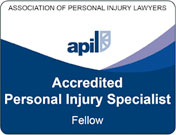Blood clot negligence claims
If you’ve suffered as a result of a blood clot that wasn’t diagnosed quickly enough, or was caused by the mistakes of medical practitioners, then the experts at Potter Rees Dolan are here to help you claim compensation.
Blood clots can occur at any time and vary in their severity. In some cases, the consequences of blood clots can be very severe, which is why a failure to deal with one properly could lead to a serious claim for medical negligence.
The Manchester-based team here at Potter Rees Dolan has some of the best clinical negligence solicitors in the country, and we can help you make sense of what has happened to you, as well as help you to recover the compensation you deserve. Our partners Helen Dolan, Lesley Herbertson and Gill Edwards all feature in the prestigious Legal 500 and Chambers guides, along with Senior Solicitor Helen Budge, illustrating the calibre of our legal professionals.
If you think you are entitled to compensation and are ready to start your blood clot negligence claim, call us on 0800 027 2557. If you’d prefer to send us a message, please use our online enquiry form.
What are blood clots?
Blood clots are a natural part of your body’s ability to manage injuries. They are vital in encouraging your body’s healing process if you have sustained a cut or similar superficial injury, but they can become problematic if they form in veins or arteries and block them.
Clots can be caused by sitting in one place for too long, including during long flights (deep vein thrombosis); they can also occur if your medication isn’t managed properly, or by immobility after a surgical procedure. In some cases, they can result in pulmonary embolism, kidney failure or even death.
How will I know if my blood clot was caused by medical negligence?
You may have been a victim of medical negligence if any of the following failures of care have affected you:
- Failure to provide heparin or prophylactic anticoagulants to prevent clots
- Failure to diagnosis and treat a DVT
- Failure to diagnose and treat a pulmonary embolism
- Failure to provide clot-busting drugs once a pulmonary embolism has occurred
- Administering clot-busting drugs unnecessarily, causing a stroke
How can I start a blood clot negligence claim?
Potter Rees Dolan’s clinical negligence team has earned a reputation as one of the very best in the UK. Boasting extensive medical insights and a combined experience in serious injury law exceeding 60 years, our team has shown an unwavering dedication to helping families recover the compensation that they are entitled to.
About Helen Dolan, head of the department, Chambers 2020 says: “Helen regularly handles complex claims, such as those related to psychiatric care. She has further expertise in spinal injury, surgical negligence and cerebral palsy claims, as well as breach of duty cases. One source states: 'Her attention to detail and knowledge of the case inside and out was exemplary.”
The same publication said Lesley Herbertson “is very good on the complex details of the case and is able to translate this to clients”.
Meanwhile, Gill Edwards is described as being “incredibly good with clients - they really warm to her - and very good on the medical details”. Client feedback quoted by Chambers stated: “The way that she helped me is amazing. She is fantastic."
The Legal 500 describes both Helen Budge and Hannah Bottomley as "approachable, supportive, thorough and extremely knowledgeable. They are also happy to listen to our suggestions and together we have an excellent plan in place."
Additionally, Chambers 2019 calls our clinical negligence team as a whole a “well-regarded team with an impressive caseload of complex clinical negligence work” and says that sources highlight the “really nice, bespoke, high-quality" service we offer.
More than anything, it is the empathy and care with which we act that sets us apart, and we often receive praise from our clients for this. Since we specialise in serious and catastrophic injuries, we know how difficult it can be to live with severe disability, which is why we work so hard to make the claims process as stress-free as possible.
Funding a blood clot negligence claim
We will fund your blood clot negligence claim on a “no win, no fee” basis. Our solicitors will investigate your potential claim on your behalf and you won’t need to pay anything if your case isn’t successful.
You might have an insurance policy that covers legal issues. If this is the case, we’ll identify whether you can use this policy or not at the start of your case; if it isn’t appropriate, we’ll offer you a “no win, no fee” claim instead.
What happens next
At the very start of the process, we will discuss all the circumstances around your blood clot negligence claim in as much detail as possible to understand whether you have a case or not. If we agree that your case should be investigated, we’ll help you obtain all of the evidence needed to build the best claim we can.
In the first instance, we’ll obtain evidence from your medical records and examine it in detail, before consulting with independent experts to identify whether the affected individual has received substandard treatment and if this caused the injury. When we’ve established a case for clinical negligence, we will notify the defendant that a claim is going to be made against them.
If it is not possible to reach an early settlement, it may become necessary to initiate court proceedings. We always try to progress blood clot negligence claims as quickly as possible and explore opportunities to adequately settle your case early to obtain interim or early payments.
Contact us today
Blood clots can have serious, life-changing consequences if they aren’t identified or treated quickly. If your medical professionals have failed to spot the early warning signs of a blood clot, or have neglected their duties in some other way, speak to us today on 0800 027 255 to talk about your case.
If you’d like us to call you back, fill in our contact form. If there was somebody you’d like to talk to specifically, please visit the profiles on our people page.
FAQs
How does blood clot?
Blood clots in four stages:
- Platelets form a barrier - tiny blood cells called platelets become active when a blood vessel is damaged. They accumulate, sticking to the walls of blood vessels and to each other to form a plug that fills the damaged section, thereby stopping blood from leaking out.
- Clot growth - specific proteins in your blood called clotting factors trigger a rapid chain reaction. The result is a dissolved substance in the blood, turning into long strands of fibrin that intertwine with the platelets to create a net that traps even more platelets and cells. At this point, the clot becomes tougher and more durable.
- Clot growth control - additional proteins in the body stop the growth of the clot to avoid it spreading further than it needs to.
- Breaking the clot down - once the damaged tissue has healed, the body begins to break down the clot. The fibrin strands are dissolved, and the blood reclaims the platelets and cells from the clot for future use.
What causes dangerous blood clots?
A common cause of dangerous blood clots is a lack of mobility, such as during long drives or long-haul flights. Dangerous blood clots can also form if you:
- have had recent surgery
- are aged 65 or older
- have previously had cancer or are receiving treatment for it
- have a broken bone, such as the leg or pelvis
- have sustained a bad bruise
- are overweight
- are confined to a wheelchair or bed for most of the time
- have a family history of blood clots
What are the symptoms of a blood clot?
If you have a blood clot inside your body that you cannot see, other symptoms may present themselves:
- Swelling in your arm or leg
- Skin redness
- Soreness or pain in your arm or leg
- A warm spot on your leg
If you think you have a blood clot, you should seek advice from a medical professional as soon as possible. They can be dangerous, especially if they break loose and migrate into other parts of your body.
In particular, if a blood clot moves into the lungs, it can lead to a serious condition called a pulmonary embolism. Symptoms can include:
- Difficulty breathing
- Chest pain and tightness
- A rapid heartbeat
- Fainting spells
- Fever
- A cough, potentially accompanied by blood
If you experience any of these symptoms, it is crucial that you seek medical advice immediately.
How can blood clots be treated and prevented?
If your blood clots are severe and need immediate treatment, you will most likely receive blood thinners to treat the problem. Treatment usually begins with a medicine called heparin, which is injected directly under the skin and works quickly; you might also be prescribed an oral medicine called an anticoagulant.
After a week of this treatment, medical professionals will discontinue the heparin and decide whether any anticoagulation treatment needs to continue. If this is the case, anticoagulants may be needed for up to six months or longer; how long this lasts will depend on the severity of the case, and what your medical professionals decide is the most appropriate course of treatment.
To prevent blood clots from forming in the first place, there are various actions that can be taken, as recommended by medical professionals:
- Wear loose-fitting clothes - tight clothes can restrict blood flow and encourage blood clots to form. Wearing loose-fitting clothes can help to prevent this.
- Exercise frequently - exercise can reduce the risk of developing a blood clot by encouraging the body to store less fat and cholesterol, reducing the risk of blood clots forming in the arteries and veins.
- Change your diet - reducing consumption of saturated fats and salt will help prevent dangerous blood clots from forming.
- Move around frequently - it can be tempting to sit in the same position during a long car journey or flight, or even in the office for hours on end. Getting up frequently, stretching your legs and moving around in general is key to preventing blood clots from forming.
If you suffer from reduced movement because of an injury or surgery, doctors sometimes prescribe heparin to prevent blood clots.
What are the complications of a blood clot?
Dangerous blood clots are considered a medical emergency and, as such, if you think you have one, it is imperative you seek medical assistance. Failure to identify and treat blood clots in time can have severe consequences. such as:
- Deep vein thrombosis (DVT), where the veins in the legs become obstructed by clots
- Post-thrombotic syndrome, where blood flows into other veins to increase blood pressure in the leg where a DVT took place
- Pulmonary embolism, where the blood clot moves to the lungs
- A stroke, resulting in additional complications such as paralysis
- Loss of limbs
- Death, in extreme cases
Useful Information
Deep Vein Thrombosis (DVT)
This is a blood clot in one of the deep veins in the body, usually in the large vein in the leg.
The blood clot can cause pain and swelling in the leg and can lead to complications such as pulmonary embolism.
Anyone can develop deep vein thrombosis but those with a family history, who are overweight or with other medical conditions such as cancer can be more at risk.
Another common cause of DVT is after undergoing an operation and it's estimated that 25,000 people who are admitted to hospital die from preventable blood clots each year.
This is because if you are unwell or inactive, or less active than you usually are, blood tends to collect in the lower parts of your body due to your lack of movement.
Treatment usually involved taking blood thinning medication to help reduce the blood's ability to clot.
Read about our client who was diagnosed with DVT but then developed compartment syndrome which resulted in her having an above knee amputation the same day.
Myocardial Infarction
This means 'damaged heart muscle' and is the most serious type of heart attack which needs to be treated quickly to minimise the damage to your heart.
It is usually due to a blood clot in a coronary artery in the heart which stops the blood flowing to the heart muscle.
The most common symptom of Myocardial Infarction (MI) is severe chest pain which may also travel up into your jaw and down your left or both arms.
However, some people only have mild discomfort in the chest which can sometimes feel like indigestion or heartburn.
Treatment of MI varies but usually includes pain relief medicine and restoring the blood flow in the blocked coronary artery.
Although many people make a full recovery after a Myocardial Infarction, complications can include; heart failure, abnormal heart rhythms and even a further MI.
Pulmonary Embolism
This condition occurs when there is blot clot in the artery that carries blood to the lungs.
This blockage can be potentially life-threatening as it can prevent blood from reaching the lungs.
Symptoms of a pulmonary embolism can include; chest or upper back pain, shortness of breath, coughing and feeling faint or dizzy.
The blood clot most commonly travels from a deep vein in the leg (known as Deep Vein Thrombosis) up to the lungs or the heart.
This can occur for no apparent reason but is usually caused by prolonged inactivity.
The main treatment for pulmonary embolism is through anticoagulant medication which stops the blot from clotting easily and helps the body absorb it. In more severe cases, the blockage may be removed through injections or surgical procedures.
This is because the blood tends to collect in the lower parts of the body when stationary, such as in hospital, which is where around half of the people who develop pulmonary embolism do so.
Severe cases of pulmonary embolism can lead to collapse, abnormally low blood pressure, and even sudden death.
The mortality rate of pulmonary embolism is dependant on the amount of lung which is affected and whether the patient has any other medical conditions.















